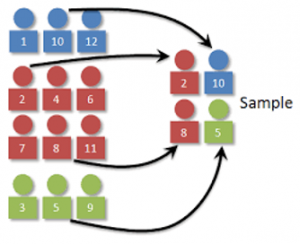ENGL 301 99A – Jessica Lee 26931758 – Assignment 1-3
Hi team!
I hope you are all having a great day. Please find below my definition assignment for the term “stratified sampling”.
Objective & Criteria
Assignment 1-3 is a practice for students to break down a relatively complex term into three kinds of definitions: a parenthetical definition, a sentence definition, and an expanded definition. Through the use of these three definitions, audiences with little to no prior knowledge of a particular subject should be able to gain a better understanding towards the particular term and area of knowledge.
Situation & Audience:
A sociologist explaining the term “stratified sampling” to a marketing intern
Term:
Stratified Sampling
Parenthetical Definition:
Stratified sampling is a selection method where subjects are chosen from categorized subpopulations.
Sentenced Definition:
Stratified sampling is a method of sampling where the population is divided into different layers or stratum, according to their shared attributes such as income or educational attainment. This type of selection process looks specifically at population characteristics instead of randomly picking out population samples.
Expanded Definition:
Stratified sampling is a common sampling method where the population is partitioned into smaller sampling groups known as strata. Strata is formed according to the sampling group’s shared attributes or characteristics such as income or educational attainment. Stratified sampling is often known as proportional random sampling or quota random sampling.
Compared to random sampling where samples are often times picked out by random directly from the greater population, stratified sampling divides the population into homogenous groups, allowing researchers to identify a sample group that best represents the entire population. Stratified sampling, however, does not define its sample frame by identifying the nth element of the sampling frame as done in systematic sampling.
Stratified sampling is most often used by sociologists or researchers for data and insight collections. It is, however, not only used within the fields of sociology and the practice can often be found in the realms of science or even marketing research. Prior to conducting research, key attributes will be identified for dividing the entire population in order to form stratum (plural for strata). Key attributes are often identified to best represent the population of question. For instance, if a researcher would like to research on whether international students experience depression more than local students in a specific university, the student population will then be categorized into different layers or stratum. The first layer will separate international students from local students, then the students will be grouped according to gender, age, race, or ethnicity. Finally, by selecting a random sample from each stratum using stratified sampling, it is ensured that students with all different kinds of backgrounds and identities are included in the research.

stratified sampling | source: Section 1.4: Other Effective Sampling Methods.” Chapter 1, https://faculty.elgin.edu/dkernler/statistics/ch01/1-4.html
Figure 1 shows an example of stratified sampling in visuals. Imagine a researcher wants to find out what after-school activities do pupils enjoy the most so they choose three year groups (as color coded by blue, red and green). Then, they stratify sample four people (numbered 2, 5, 8, and 10) from the three year groups and conduct their study. This specially formed group is believed to best represent the larger population and is what we call, stratified sampling.
Works Cited
Hayes, Adam (2020). Stratified Random Sampling. Retrieved September 29, 2020, from https://www.investopedia.com/terms/stratified_random_sampling.asp
Section 1.4: Other Effective Sampling Methods.” Chapter 1, https://faculty.elgin.edu/dkernler/statistics/ch01/1-4.html
Salkind, Neil J. Encyclopedia of Research Design. 0 vols. Thousand Oaks, CA: SAGE Publications, Inc., 2010. SAGE Research Methods. Web. 29 Sep. 2020, doi: 10.4135/9781412961288.
I hope this has been an insightful read and please feel free to let me know should you have any questions.
Best,
Jessica
Leave a Reply